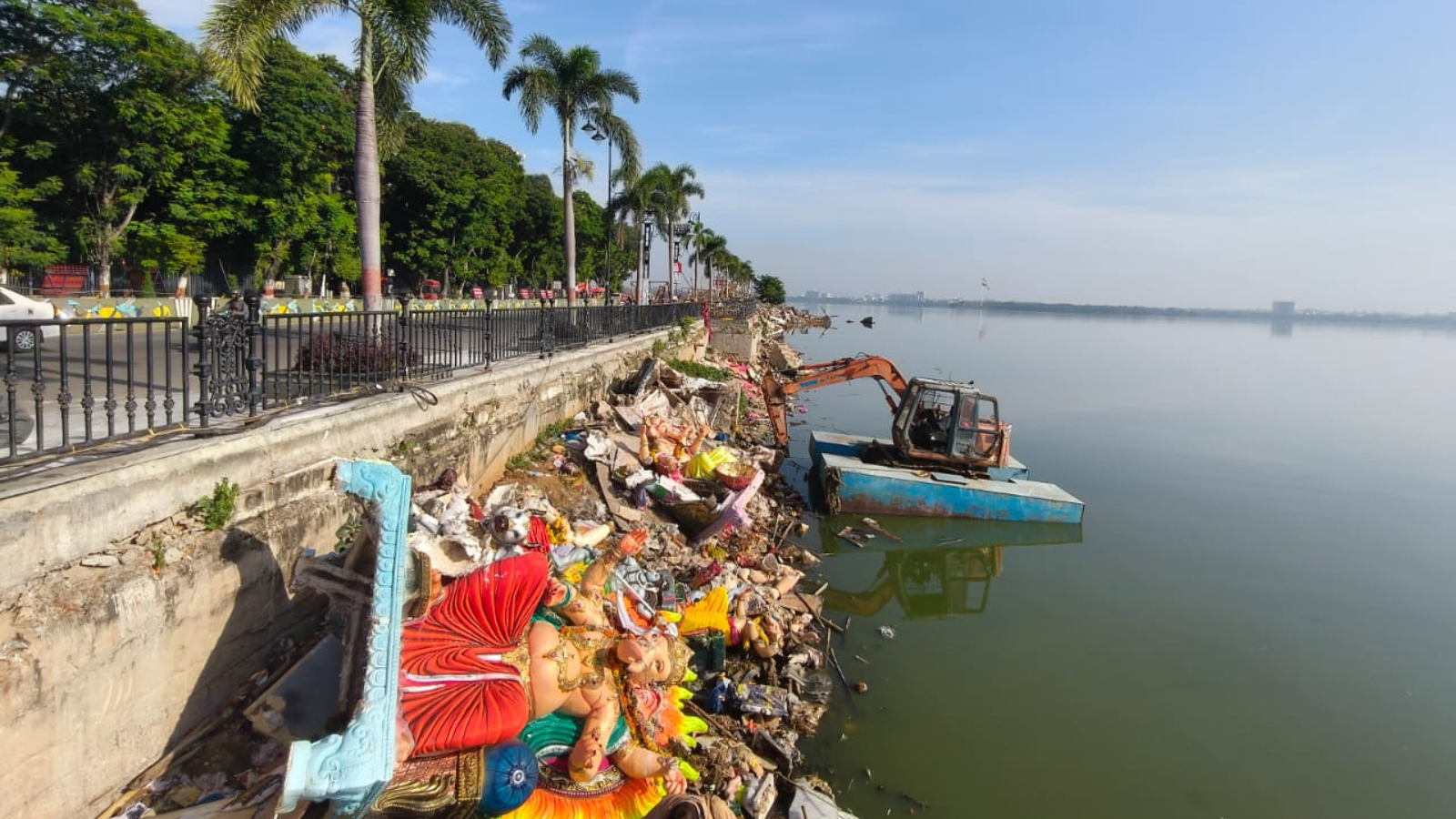Tank Bund has temporarily swapped its status as Hyderabad’s postcard-perfect lakefront for that of a scrapyard.
Published Sep 10, 2025 | 8:00 AM ⚊ Updated Sep 10, 2025 | 8:00 AM

The aftermath of idol immersions at Hyderabad's Hussain Sagar
Synopsis: The Hussain Sagar and its adjoining Tank Bund stretch lie buried under debris days after the Ganesh Nimajjanam festivities in Hyderabad, with heaps of idol fragments, wet waste, bamboo poles and metal scraps turning the lakefront into a dump. Municipal workers have been toiling for days to clear the debris. The police, who had plastered ‘no idol immersion’ hoardings along the lake last year, ensured a seamless immersion process this time.
Hyderabad’s Ganesh Nimajjanam festivities over the weekend of 6 and 7 September were nothing short of grand. Lakhs of devotees thronged the city’s streets, with processions carrying idols of every imaginable size towards the lakes.
The Tank Bund stretch along Necklace Road, adjoining Hussain Sagar, became the epicentre of the spectacle, including the immersion of the iconic 69-foot Khairatabad Bada Ganesh.
The state government made it a point of honour, with the police and administration taking pride in their arrangements for the festivities.
But the jubilant celebrations have come at a cost, leaving behind a trail of debris more reminiscent of a storm’s aftermath than a religious festival.
Tank Bund has temporarily swapped its status as Hyderabad’s postcard-perfect lakefront for that of a scrapyard. For a festival intended to usher in a hassle-free year, the idol immersions have brought a days-long cleanup for city municipal workers, and a constant eyesore for residents.
The once-picturesque Necklace Road is strewn with iron rods, idol fragments, heaps of wet waste, flowers, leaves, and bamboo poles.
Craters mark the footpaths and some lamp posts are bent, as though the pavements buckled under the weight of the festivities. The road that usually attracts joggers and families now greets visitors with mounds of rubbish and a worsening stench.
Adding to the scene are scrap dealers, who now line the Tank Bund. Trucks of all sizes carry away iron rods and metal scraps scavenged from the remains. Men with blow torches and cutters hack at the debris, gathering it for resale.
One scrap dealer, speaking anonymously, told South First: “Our owners have asked us to come here and gather the metal for reselling. Just since morning, I have moved about two tipper loads of metal back to the shop.”
Inside the lake, the scene is no better. Massive cranes float on makeshift pontoons, clawing at half-immersed idols. The water, calm on the surface, hides a grim underbelly where remnants of Ganesha statues and ritual paraphernalia sink.
While Hussain Sagar has never been known for pristine water, new patches of white now dot its surface.
“We have been working for the past two days but have barely made a dent in the cleaning. These idols are everywhere, and to add to the troubles, there were many larger idols this year, too,” a GHMC worker, toiling under the sun, told South First.
“It is all along the lake’s banks over here. Cleaning this will take about a whole month of continuous work.”
Prior to the festival, the Central Pollution Control Board (CPCB) had suggested that administrations impose a height limit on idols, but most installations ignored the guidelines.
Having a larger idol than the previous year has become the norm, while going smaller is no longer seen as an option for most communities.
The CPCB also recommended that lake immersions be discouraged, and that cleanup be completed within 24 hours.
Yet, the same police who had plastered ‘no idol immersion’ hoardings along the lake last year ensured a seamless immersion process this time.
(Edited by Dese Gowda)
